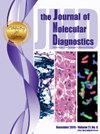Single-Tube, Switched Temperature Amplicon Barcoding for Multiplex Detection of Rare Mutations in Circulating Tumor DNA
IF 3.4
3区 医学
Q1 PATHOLOGY
引用次数: 0
Abstract
Detection and analysis of circulating tumor DNA (ctDNA) as a biomarker for cancer is a promising approach. Applications for ctDNA analysis include screening, diagnosis, treatment selection, treatment monitoring, minimal residual disease detection, and recurrence monitoring. Detection of ctDNA is challenging and requires highly sensitive methods. Approaches such as digital PCR are appropriate when only a small number of targets is being interrogated, whereas next-generation sequencing (NGS) is typically used when more targets are being analyzed. There are several NGS methods available, some of which are published and can be implemented in laboratories with the required expertise while other, commercial approaches are proprietary and are only available as a service. Of the published methods, most use some kind of unique molecular identifiers (or barcodes) to facilitate NGS error correction and detection of rare mutations at mutant allele frequencies of <0.1%. However, incorporation of barcodes and amplification of the resulting libraries are not trivial and typically require multiple steps and considerable hands-on time by an experienced molecular biologist. Herein, a novel approach for switched temperature amplicon barcoding was used, in which barcoding and library amplification were performed in the same tube using a two-stage PCR protocol with no additional manipulation. Total hands-on time was 10 to 15 minutes for reaction setup; the library was then cleaned and was ready for sequencing.
单管开关温度扩增子条形码(STAB-seq)用于循环肿瘤DNA中罕见突变的多重检测。
循环肿瘤DNA (ctDNA)的检测和分析是一种很有前景的癌症生物标志物。ctDNA分析的应用包括筛查、诊断、治疗选择、治疗监测、最小残留疾病检测和复发监测。ctDNA的检测具有挑战性,需要高灵敏度的方法。数字PCR等方法适用于只检测少量靶标的情况,而下一代测序(NGS)则适用于需要更多靶标的情况。有几种可用的NGS方法,其中一些已发表,可以在具有所需专业知识的实验室中实施,而其他商业方法是专有的,只能作为服务提供。在已发表的方法中,大多数使用某种独特的分子标识符(UMI's或条形码)来促进NGS错误纠正和检测突变等位基因频率(MAF)的罕见突变
本文章由计算机程序翻译,如有差异,请以英文原文为准。
求助全文
约1分钟内获得全文
求助全文
来源期刊
CiteScore
8.10
自引率
2.40%
发文量
143
审稿时长
43 days
期刊介绍:
The Journal of Molecular Diagnostics, the official publication of the Association for Molecular Pathology (AMP), co-owned by the American Society for Investigative Pathology (ASIP), seeks to publish high quality original papers on scientific advances in the translation and validation of molecular discoveries in medicine into the clinical diagnostic setting, and the description and application of technological advances in the field of molecular diagnostic medicine. The editors welcome for review articles that contain: novel discoveries or clinicopathologic correlations including studies in oncology, infectious diseases, inherited diseases, predisposition to disease, clinical informatics, or the description of polymorphisms linked to disease states or normal variations; the application of diagnostic methodologies in clinical trials; or the development of new or improved molecular methods which may be applied to diagnosis or monitoring of disease or disease predisposition.

 求助内容:
求助内容: 应助结果提醒方式:
应助结果提醒方式:


